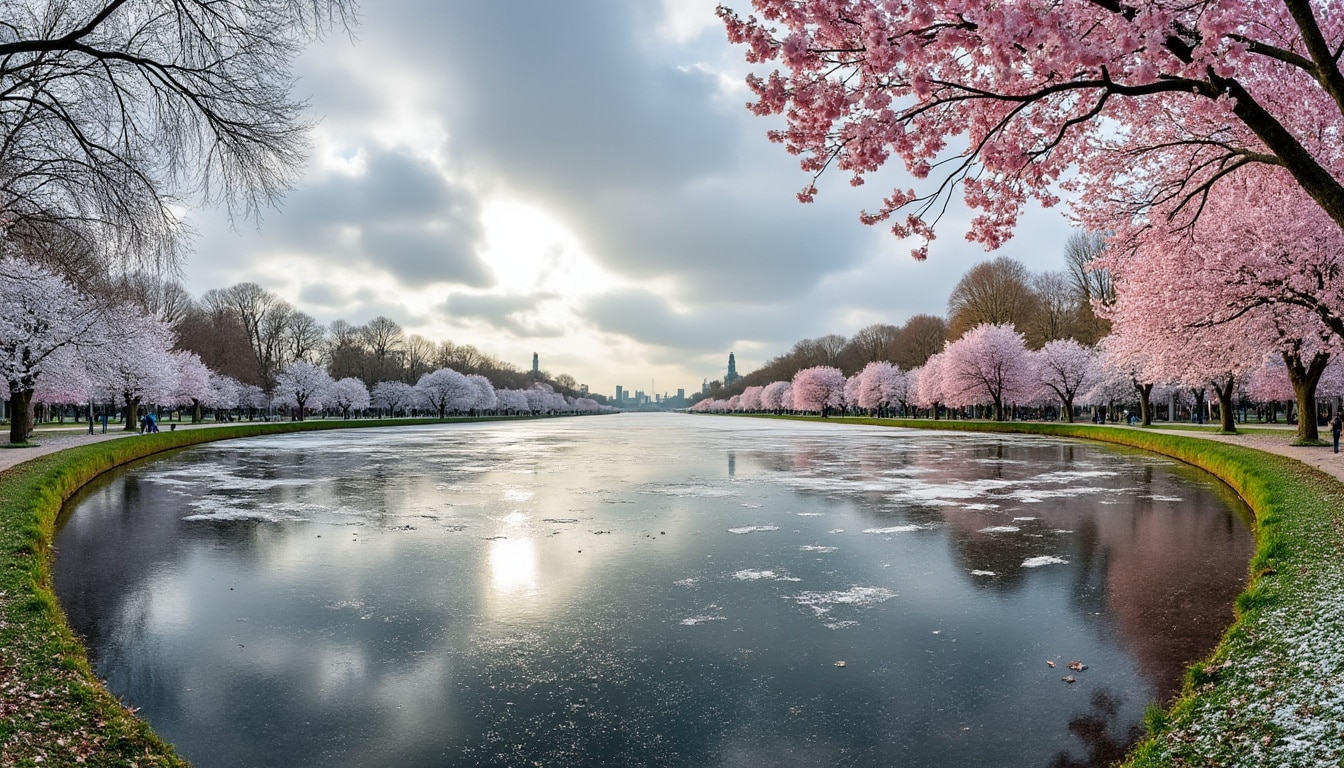Berlin, with its vibrant culture and rich history, attracts millions of tourists each year. A key factor to consider when planning your visit is the weather, which shifts dramatically from month to month. This article provides an in-depth look at the weather patterns, helping both locals and tourists to make the most of what Berlin has to offer. From the icy winters with occasional snowfall to the warm, sunlit days of summer, understanding the weather can enhance your experience in Germany’s capital.
January: Embracing the Cold in Berlin
Berlin’s winter is in full swing by January, making it the coldest month of the year. The average temperature hovers around a frosty 0.5°C (33°F), with lows frequently dipping to -1.9°C (28°F). Snow can be sporadic, but it adds a magical touch to the cityscape. During this time, visitors are more likely to engage in indoor activities, enjoying Berlin’s famous Christmas markets or exploring its numerous museums.
Despite the chill, Berlin’s winter charm is undeniable. The city’s architecture transforms into a picturesque scene when covered in a thin layer of snow. Learn more about Berlin’s cold weather here. It’s also important to note that January experiences about 56 mm (2.2 inches) of precipitation, distributed across nine rainy days. The city experiences limited sunshine, averaging only about 2.7 hours of sunshine per day, contributing to the overall sense of coziness.

Surviving the Low Temperatures
To stay comfortable during Berlin’s harsh winter, dressing warmly is key. Layering is advisable, starting with thermal wear, sweaters, and a reliable winter coat. Accessories such as gloves, hats, and scarves are essential to ward off the piercing cold. Despite the low temperatures, the city’s efficient public transport system ensures easy travel across Berlin, whether you’re headed to a quaint café or an art gallery.
The humidity in January is relatively high at 84%, which might make the cold feel even more biting. Interestingly, January’s average wind speed is around 4 m/s, adding to the chill factor. However, the combination of snow and cold enables a range of activities such as ice-skating at one of Berlin’s seasonal rinks. For those who prefer staying indoors, the city’s historical museums and warm coffee shops offer refuge.
April: The Prelude to Summer
April marks the beginning of a pleasant transition towards warmer months. The average temperature tends to hover around 9.7°C (49.4°F), with daytime highs potentially reaching 14.4°C (57.9°F). Precipitation in April is lower compared to other months, with an average of 42 mm (1.7 inches) over eight rainy days. This dryness, coupled with around 8.7 hours of sunshine per day, creates the perfect conditions for outdoor excursions.
Spring brings with it a sense of renewed energy and lush greenery, transforming Berlin into an ideal spot for nature lovers. Parks like Tiergarten and Treptower Park become popular hangouts, where people bask in the gentle sun or enjoy outdoor cafes. Explore all about Berlin’s seasons here. The relatively mild weather means lighter layers are sufficient, although an umbrella might still be handy for the occasional spring shower.
The moisture levels decrease to a comfortable 68%, making outdoor activities enjoyable. April is a favored month for city tours and open-air markets. Often, tourists take advantage of the pleasant weather to explore Berlin’s historical sites and bustling neighborhoods, indulging in activities that colder months make less inviting.
The Best Activities for April
This time of year hosts a range of events, such as street food festivals and open-air concerts, capturing the lively spirit of Berlin. Historical sites like Brandenburg Gate and the Berlin Wall Memorial are especially appealing in the inviting spring weather. Those interested in picking up some local produce will find that April is a fantastic time to visit Berlin’s farmers’ markets, which offer fresh, seasonal produce.
Furthermore, April’s longer daylight hours mean tourists and locals can spend more time exploring without rushing back as the sun sets. Renting a bike is a popular way to navigate the city, offering a unique perspective of Berlin and affording the chance to stop and admire the beginnings of spring blooms.
July: Summer in Full Swing
July is the warmest month in Berlin, characterized by long, sun-filled days and a bustling city atmosphere. The average temperature peaks at 19.8°C (67.7°F), with highs occasionally reaching 24°C (75.2°F). This month also records the highest precipitation rate, with 81 mm (3.2 inches) across nine rainy days, though showers are typically brief.
Summer in Berlin offers a diverse array of activities, from lounging in the parks to attending the city’s many cultural festivals. The increased daylight—about 11 hours of sunshine per day—encourages events that carry on late into the evening. Discover Berlin’s weather year-round.
Enjoying Berlin Outdoors
The city opens its doors to countless open-air events, rooftop bars, and outdoor swimming pools. The Spree River provides an idyllic backdrop for picnics and leisurely boat trips, while the city’s extensive network of bike trails makes for perfect exploration routes.
Those visiting Berlin in July should embrace lighter clothing and sunscreen, as the humidity rises to 65%, adding to the warmth. However, the city’s vibrant summer atmosphere offers plenty of ways to stay cool, from ice cream vendors to shaded beer gardens.
October: Autumn’s Golden Embrace
October signals the arrival of autumn, a season marked by brilliant fall foliage and milder temperatures. The average temperature in Berlin drops to a cooler 10.4°C (50.7°F), with possible highs of 13.8°C (56.8°F). Rainfall is moderate, around 49 mm (1.9 inches), distributed over eight rainy days.
This time of year brings a picturesque landscape, as the city’s parks and streets are adorned with vibrant autumn hues. The crisp air creates a perfect backdrop for leisurely walks through historic streets, while cafes offer comforting hot beverages. Understand Berlin’s rain patterns here.
Exploring Autumnal Attractions
One of the highlights of October is the Festival of Lights, where Berlin’s most famous landmarks are illuminated with spectacular light installations. Visitors can also enjoy Oktoberfest celebrations, although on a smaller scale compared to Munich. Meanwhile, the crisp weather is perfect for exploring Berlin’s museums and theaters, which provide warm and inviting respites from outdoor chills.
The relative humidity in October is around 80%, paired with moderate winds, making it necessary to dress in layers. Enjoy the city’s legendary street food, perfect for warming up during cooler days, while visiting the numerous markets offering autumn harvests.
December: A Winter Wonderland
Entering December, Berlin transitions into a winter wonderland, with a festive spirit permeating the city. Temperatures average around 2.2°C (36°F), with lows dropping to 0.1°C (32.1°F). Precipitation increases slightly to 54 mm (2.1 inches), with nine rainy days anticipated.
This chilly backdrop is made magical by the city’s Christmas markets, which offer traditional German delicacies, handcrafted goods, and festive cheer. The air is filled with the aroma of mulled wine and roasted chestnuts, while children can enjoy ice-skating in plazas turned into winter parks. Get insights into Berlin’s weather patterns here.
Winter Activities in Berlin
As daylight shortens to about 2.6 hours of sunshine per day, the city sparkles with holiday lights, creating a cozy and festive atmosphere. Activities range from attending orchestral concerts to enjoying theater performances of classic holiday tales.
With humidity at 84%, bundling up in warm clothing is vital. Visitors can immerse themselves in Berlin’s art scene, with galleries hosting special exhibitions during the winter months, providing both cultural enrichment and warmth.
FAQ
What is the best time to visit Berlin? For good weather, consider visiting from May through September, when temperatures are moderate and the city is alive with festivals.
How does Berlin’s weather affect outdoor activities? While winter months offer indoor opportunities, spring and summer are ideal for exploring parks and attending outdoor events.
What type of clothing should I pack for Berlin? In winter, pack warm layers and accessories like hats and gloves; for summer, lighter clothing and sunscreen are essential.
Understanding Berlin’s weather can greatly enhance one’s experience, whether you’re a local or a visitor. Embracing the city’s seasonal changes offers a unique perspective on its charm and cultural richness.

Navigating the climate in Berlin involves understanding its unique variations across the seasons. The city, known for its cultural vibrancy and historical significance, experiences a maritime temperate climate that influences both residents and tourists. Whether you’re strolling the streets of…

As winter descends upon Berlin, the city’s vibrant streets transform into a mystical canvas painted with frosty hues. Locals and visitors alike brace for the biting chill, exploring unique ways to embrace the city’s cold climate. From cozy cafés to…

Flooding and natural risks in Berlin
The vibrant city of Berlin, known for its rich history and dynamic urban culture, faces its share of natural challenges, particularly flooding. With its intricate network of rivers and canals, Berlin’s flood risks have increasingly become a focal point for…

Berlin, the vibrant capital of Germany, is no stranger to fluctuating weather patterns. As summer approaches, it transforms into a bustling hub where residents and tourists alike bask in the warmth of the season. With its distinct urban culture and…

Is Berlin warm throughout the year?
Berlin, the bustling capital of Germany, is a city rich in history, culture, and diverse climate patterns. As a key player in the cultural and political landscape of Europe, understanding Berlin’s weather throughout the year is crucial for both residents…

Rain and precipitation in Berlin
Berlin, well-known for its rich historical and cultural heritage, is also characterized by its distinct climate patterns. The city receives an average of 591 mm of rainfall annually, making rain and precipitation a significant aspect of life here. This article…

In Berlin, the allure of a new day begins with the gentle rise of the sun, casting its warm glow over the city’s iconic skyline. The sunrise times in this vibrant metropolis not only mark the beginning of a new…

The city of Berlin, capital of Germany, boasts a rich tapestry of culture and history, but many might not realize the weather here is just as compelling. Situated at a latitude of approximately 52 degrees north, Berlin experiences a moderately…

What is the weather like in Berlin?
Berlin, the vibrant capital of Germany, is known not only for its rich history and dynamic cultural scene but also for its unique weather patterns that can vastly vary throughout the year. Whether you’re a resident soaking in the Berlin…




